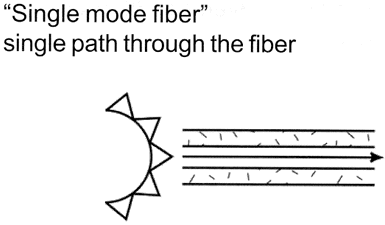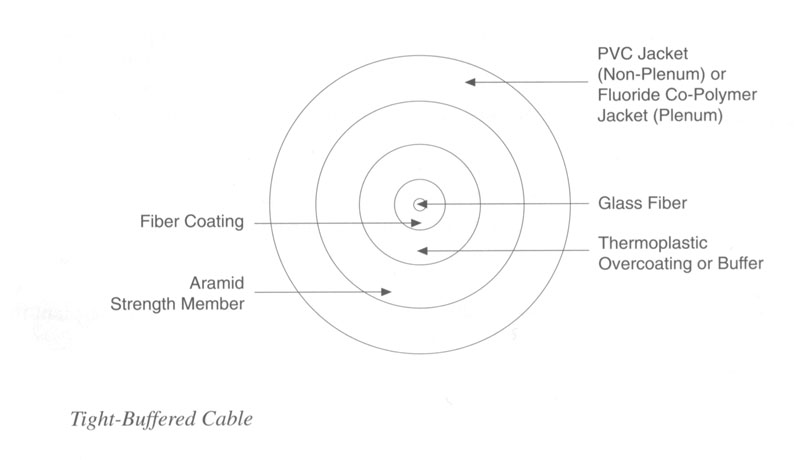FIBER OPTICS
There are three types of fiber optic cable commonly used: single mode,
multimode and
plastic optical fiber (POF).
Transparent glass or plastic fibers which allow light to be guided from one end to the other with minimal loss.
Fiber optic cable functions as a "light guide," guiding the light introduced at one end of the cable through to the other end. The light source can either be a light-emitting diode (LED)) or a laser.
The light source is pulsed on and off, and a light-sensitive receiver on the other end of the cable converts the pulses back into the digital ones and zeros of the original signal.
Even laser light shining through a fiber optic cable is subject to loss of strength, primarily through dispersion and scattering of the light, within the cable itself. The faster the laser fluctuates, the greater the risk of dispersion. Light strengtheners, called repeaters, may be necessary to refresh the signal in certain applications.
While fiber optic cable itself has become cheaper over time - a equivalent length of copper cable cost less per foot but not in capacity. Fiber optic cable connectors and the equipment needed to install them are still more expensive than their copper counterparts .
Single Mode cable is a single stand (most applications use 2 fibers) of glass fiber with a diameter of 8.3 to 10 microns that has one mode of transmission. Single Mode Fiber with a relatively narrow diameter, through which only one mode will propagate typically 1310 or 1550nm. Carries higher bandwidth than multimode fiber, but requires a light source with a narrow spectral width. Synonyms mono-mode optical fiber, single-mode fiber, single-mode optical waveguide, uni-mode fiber.
Single Modem fiber is used in many applications where data is sent at multi-frequency (WDM Wave-Division-Multiplexing) so only one cable is needed - (single-mode on one single fiber)
Single-mode fiber gives you a higher transmission rate and up to 50 times more distance than multimode, but it also costs more. Single-mode fiber has a much smaller core than multimode. The small core and single light-wave virtually eliminate any distortion that could result from overlapping light pulses, providing the least signal attenuation and the highest transmission speeds of any fiber cable type.
Single-mode optical fiber is an optical fiber in which only the lowest order bound mode can propagate at the wavelength of interest typically 1300 to 1320nm.

jump to single mode fiber page
Multi-Mode cable has a little bit bigger diameter, with a common diameters in the 50-to-100 micron range for the light carry component (in the US the most common size is 62.5um). Most applications in which Multi-mode fiber is used, 2 fibers are used (WDM is not normally used on multi-mode fiber). POF is a newer plastic-based cable which promises performance similar to glass cable on very short runs, but at a lower cost.
Multimode fiber gives you high bandwidth at high speeds (10 to 100MBS - Gigabit to 275m to 2km) over medium distances. Light waves are dispersed into numerous paths, or modes, as they travel through the cable’s core typically 850 or 1300nm. Typical multimode fiber core diameters are 50, 62.5, and 100 micrometers. However, in long cable runs (greater than 3000 feet [914.4 meters), multiple paths of light can cause signal distortion at the receiving end, resulting in an unclear and incomplete data transmission so designers now call for single mode fiber in new applications using Gigabit and beyond.
The use of fiber-optics was generally not available until 1970 when Corning Glass Works was able to produce a fiber with a loss of 20 dB/km. It was recognized that optical fiber would be feasible for telecommunication transmission only if glass could be developed so pure that attenuation would be 20dB/km or less. That is, 1% of the light would remain after traveling 1 km. Today’s optical fiber attenuation ranges from 0.5dB/km to 1000dB/km depending on the optical fiber used. Attenuation limits are based on intended application.
The applications of optical fiber communications have increased at a rapid rate, since the first commercial installation of a fiber-optic system in 1977. Telephone companies began early on, replacing their old copper wire systems with optical fiber lines. Today’s telephone companies use optical fiber throughout their system as the backbone architecture and as the long-distance connection between city phone systems.
Cable television companies have also began integrating fiber-optics into their cable systems. The trunk lines that connect central offices have generally been replaced with optical fiber. Some providers have begun experimenting with fiber to the curb using a fiber/coaxial hybrid. Such a hybrid allows for the integration of fiber and coaxial at a neighborhood ********. This ********, called a node, would provide the optical receiver that converts the light impulses back to electronic signals. The signals could then be fed to individual homes via coaxial cable.
Local Area Networks (LAN) is a collective group of computers, or computer systems, connected to each other allowing for shared program software or data bases. Colleges, universities, office buildings, and industrial plants, just to name a few, all make use of optical fiber within their LAN systems.
Power companies are an emerging group that have begun to utilize fiber-optics in their communication systems. Most power utilities already have fiber-optic communication systems in use for monitoring their power grid systems.










.gif)
.gif)
.gif)
.gif)
.gif)
.gif)
.gif)

 رد مع اقتباس
رد مع اقتباس


مواقع النشر (المفضلة)